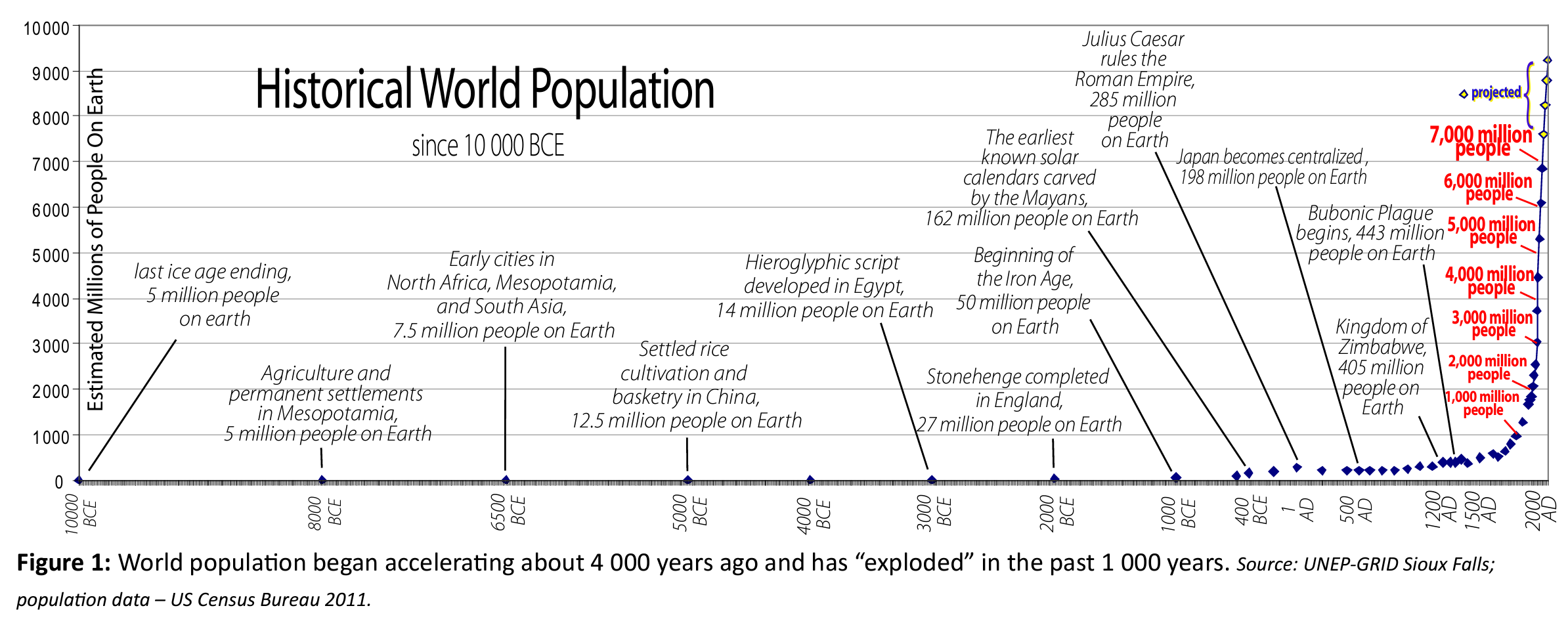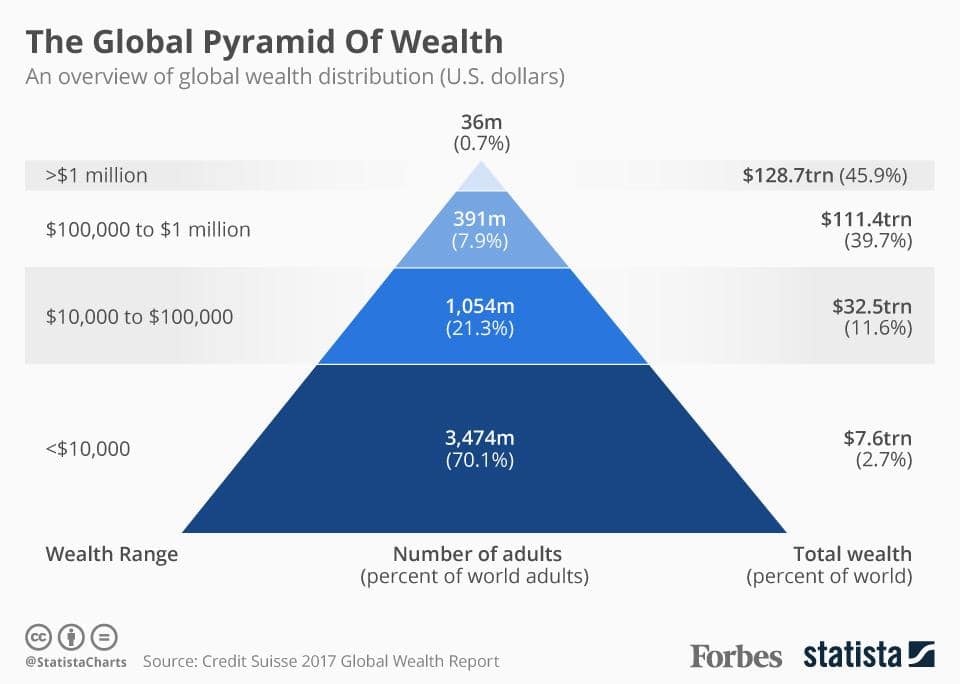In 1968, Paul Erlich published The Population Bomb, predicting coming famine and mass death, but it is worth considering how zero population growth works. Erlich’s predictions didn’t pan out but his ideas launched a debate still raging today. A key element of the population bomb is “carrying capacity”. Carrying capacity means we need equity and sustainably for our society to function effectively. Unless these are met, we place tremendous stress on Earth, and on each other, and we will eventually bring about our self-inflicted demise.
Are we past carrying capacity? Should we go back to 2 billion? Would you volunteer to be part of the reduction? Or can we be 40 billion? If its 2 billion, how do we change to get back to 2 billion? Or to 40 billion? Let’s examine some of these factors.
Earth Population By Year
The earth’s population is currently about 8.2 billion. Actual numbers are no more than guesses. In the 1950’s it was about 2 billion. Back 200 years ago in the 1800’s, the population was under 1 billon. It only grew past 2 billion in 1928 due to antibiotics, sanitation, industrialisation along with a decrease in infant mortality. More growth happened in the 60’s and 70s with high birth rates and a rapid increase in life expectancy from 30 to 60 years. Birth rates per household were still high. Education, contraception and society changed birth rates to below replacement in the 90’s. Now, some predict the population may not make it to 10 billion. External risks (meteors) or internal risks (nuclear war, earth catastrophes, disease, climate change) could change the current population overnight.

Population Peaks in 2040
Depending on the model, peak population will be somewhere between 2050 to 2060. It’s most unlikely to be 2100.

Food Supply
Walter Malthus (1800’s) and the Malthusianism theory is that population growth is potentially exponential while the growth of the food supply or other resources is linear. This eventually reduces living standards to the point of triggering a population decline.
Green Revolution
The concept was dispelled with the Green Revolution. Norman Borlaug is credited with being the father of the Green Revolution in the sixties and seventies with the great advances in agricultural yields. New types of wheat in Mexico, and new types of rice in India yielding more than we ever had. Along with drought-resistant, flood-resistant, pest and disease-resistant plants the “carrying capacity” soared.
Since the 1950s, there have been dramatic decreases in the percentage of malnourished people in the world, from some 65% in 1950 to 25 % in 1970, 15% in 2000 and 9% in 2020. Remarkably, during this same 70 years, global population has risen from 2.5 billion people to 8 billion.
Is there any excuse why 0.8 billion people go to bed hungry at night? Perversely, more die from obesity and lifestyle diseases than hunger.
Precision Fermentation Disrupts Animal Farming
Part of this inequity is 40% of the food grown is used to feed animals that we eat for protein. The potential for precision fermentation is capable of slashing agricultural land use by 84% by 2040, with the efficiency of protein conversion from starch to protein going from 1% to 95%.
Space Needed for People
If all of the 8.2 billion were in cities, how much space would be needed? Social media posts about the world’s population fitting into a 50.8-mile x 50.8-mile square are missing context such as water, sewage, energy, housing, recreation and transportation. Given a large city function, humans do not occupy much space. A useful measure would be the population density of Paris. Greater Paris -Metropole du Grand Paris- (MGP) is a densely occupied territory which is almost completely urbanised. The average population density is 20,641 inhabitants per km2 so 400,000 km2.

The central area is the most dense with over 500 inhabitants per hectare (50,000 per km2) but lower density, down to 50 people per hectare (5,000 per km2), in the south east areas of Territoires Grand Paris Sud Est Avenir and Grand-Orly Seine Bièvre. At 20,000/km2. the area for all global people would ~400,000 km2 or smaller than Texas which is 670,999km2, or countries of about 400,000km2 which include Germany, Sweden, Italy, Spain and Morocco.
Resources Used by Population
While the population or area needed for the population, are both physical, the disparity is resources. One billion people consume 71% of all resources. A billion people consume less than 1% of resources, while the balance of 6b, 28%. Viewed in money terms, 1b eke out a living on less than $1 per day, 6b $2 to $100 per day and the wealthy $100. Even in the USA, the top 1% of households hold 32.3% of the country’s wealth, while the bottom 50% just 2.6%. About 400 billionaires in the USA hold 50% of the wealth of America.
Another measure of wealth may be the amount of steel per capita. The USA has 10 tonnes of steel per person. In Nigeria, it is 1. Steel builds cars, public transport, hospitals, schools, and infrastructure, often in combination with cement. The carbon emissions from steel (7%) and concrete ( 8%) make up a sizeable emissions of the 1 billion resource-intensive countries.

| Net Worth | Number of Adults | Share of Adults | Total Wealth | Share of Global Wealth |
|---|---|---|---|---|
| More than $1 million | 59.4M | 1.1% | $208.3T | 45.8% |
| $100,000 to $1 million | 642.0M | 12.0% | $178.9T | 39.4% |
| $10,000 to $100,000 | 1.8B | 34.4% | $61.9T | 13.6% |
| Less than $10,000 | 2.8B | 52.5% | $5.3T | 1.2% |

Energy Consumption
Over a billion people live in energy poverty and the outcome of insufficient energy usually translates into the impossibility to develop agriculture and manufacturing. It keeps the poorest countries trapped in a vicious circle: they cannot afford the energy that can drive them out of poverty. Energy poverty is means you spend money or time collecting firewood for cooking, or unable to keep cool.
In a renewable energy world, less than 50% of energy is needed to provide the same services. For example an incandescent light consumes 75Watts per hour. An LED light 5W. Yet the outcome of lighting is the same. Transportation requires 10% of the energy with electric vehicles than gasoline vehicles. Renewable energy is lower cost, and harvests free energy. Initial upfront capital cost can be amortised over 10 or 20 years. Storage with batteries turns electricity from synchronous to asynchronous.

Peak Birth Contributes to Zero Population Growth
Over 90 countries have passed peak birth of about 2.1 children per woman. Many countries are in population decline. Religion, education and contraception mean most countries will progress to falling population. Read more here
Global Employment
In 2023, there were estimated to be approximately 3.4 billion people employed worldwide, compared with 2.27 billion people in 30 years previously in 1991.

https://www.statista.com/statistics/1258668/global-employment-figures-by-gender
The Rise of Robots Will Mitigate Loss of Productivity by Humans
GDP for countries is dependent on human capital. Will decreased population, together with labour workforce peaking mean a lack of productive workers? Humanoid robots are coming, and estimates are that for every person, there will be as many as 1 robot. Even with a billion robots, that can work 24×7 that would be equivalent to 1 robot for every 4 people.
Read more at Human Robots are Coming
Conclusion of Carrying Capacity
The world has enough for everyone’s need, but not enough for everyone’s greed
Mahatma Gandhi

We see that
- The world is a system.
- We as individuals are systems.
- Our organisations and businesses are systems.
- Our communities and our nations are systems.
And they are all interconnected.

More Reading
- The Population Bomb is a 1968 book co-authored by former Stanford University professor Paul R. Ehrlich and former Stanford senior researcher in conservation biology Anne H. Ehrlich. https://en.wikipedia.org/wiki/The_Population_Bomb
- Visualizing the Pyramid of Global Wealth Distribution 2023 https://www.visualcapitalist.com/global-wealth-distribution/
- Earth’s Population too High – https://optimisticstorm.com/earths-population-is-too-high/
- Impact of AI on Job Creation and Disruption 2024 https://optimisticstorm.com/impact-of-ai-on-job-creation-and-disruption/
- Food Disruption Impacts https://optimisticstorm.com/food-disruption-impacts/
- Malthusian from Thomas Malthus: An Essay on the Principle of Population. 1798 https://en.wikipedia.org/wiki/Malthusianism
- Wikipedia: Carrying capacity: https://en.wikipedia.org/wiki/Carrying_capacity
- Australian Academy of Science: How many people can Earth actually support?:
- HowStuffWorks: Has the Earth reached its carrying capacity?: https://science.howstuffworks.com/environmental/green-science/earth-carrying-capacity.htm
- How many people can Earth actually support? https://www.science.org.au/curious/earth-environment/how-many-people-can-earth-actually-support
- One Planet, How Many People? A Review of Earth’s Carrying Capacity https://na.unep.net/geas/archive/pdfs/GEAS_Jun_12_Carrying_Capacity.pdf









